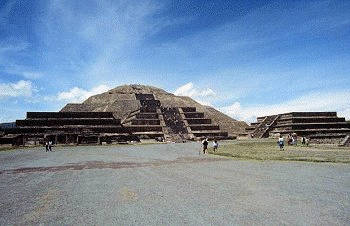
Teotihuacan:

Who were the builders of this incredible site? Known by the Maya and Aztecs as "The Place Where Men Became Gods". Orthodox archaeologists have dated the site to 500 BC to1000 AD, although there are some who assert that a revised date of 1500 BC should be considered. At the height of occupation, around 750 AD, it is estimated that some 150 000 people lived within the complex and it's surrounding areas, making it the sixth largest city in the world at that time.
The Aztecs, encountered by the Spanish conquistadors in 1519, reported that even then, the city was old beyond reckoning. Their legends tell of an epoch when the land was a paradise inhabited only by the gods. According to Aztec religion, the world has been created and destroyed four times, and that we are now living in the age of the "Fifth Sun". According to the legends, two gods volunteered themselves in the fiery sacrifice to create the fifth sun. The divine hearth was constructed at Teotihuacan, the centre of what would be the fifth world. After suitable ritual preparations were made and the gods had purified themselves, the moment came to approach the fire. Tecuciztecatl, Lord of the Snails, who had arrogantly claimed supremacy, could not muster the courage to enter the cosmic fire. Nanahuatl, the god whose form is diseased, who understood the pain of limitation and imperfection, stepped forward and threw himself into the flames. Shamed by such bravery, Tecuciztecatl followed him and became the moon. The sun did not rise immediately, however, and the gods became anxious in the oppressive darkness. Quetzalcoatl, however, found the location of the sunrise and proceeded to the east. There he welcomed the rising sun as Lord of the Dawn and, when the sun wobbled uncertainly, he steadied it as the god of wind. This is how the Fifth Sun was born.

A photographic mapping project (The Teotihuacan Mapping Project) gave archaeologists some idea of the scale of this ancient site. It coveres 8 square miles and only a fraction has been excavated. Teotihuacan was laid out in a grid pattern that is consistently oriented to 15 degrees 25 minutes east of true north, suggesting that the planners must have had a sophisticated knowledge of mathematics. Hugh Harleston Jr,an engineer, did a comprehensive mathematical survey of Teotihuacan during the '60's and'70's, and has suggested that Teotihuacan could have been designed as a kind of map of the sky. He showed that complex mathematical relationships existing between the principle structures along its main north-south axis, indicate that Teotihuacan may have been designed as a precise scale-model of our solar system, including the outer planets Neptune, Pluto and Uranus, which weren't discovered by modern astronomers until relatively recently!
Teotihuacan's major axis, called the Avenue of the Dead, is about 125 feet wide, flanked on either side by stone banks with stairs to the tops of the embankments. It is as straight as a die and exactly aligned 15 degrees 25 minutes east of due north. There are those who believe that the avenue was actually filled with water to act as an "early warning system" for earthquakes. The ripples in the water giving the inhabitants an idea of the magnitude and scale of the expected earthquake. The embankments on either side make it very difficult to walk down the avenue or to enter it from any of the side "streets". The excavated ruins comprise about two miles of the Avenue of the Dead from the Ciudadela containing the Temple of Quetzalcoatl at the south, to the Pyramid of the Moon at the north. But the Avenue is probably at least twice this length, extending south from the Ciudadela and probably continuing up into the surrounding mountains. The buildings on either side of the Avenue of the Dead from the Ciudadela to the Pyramid of the Moon, are but a fraction of the ruins that still remain to be excavated at Teotihuacan.
Even 2000 years after they were built, the size,
precision, and magnitude of the buildings at Teotihuacan remain
an impressive spectacle.